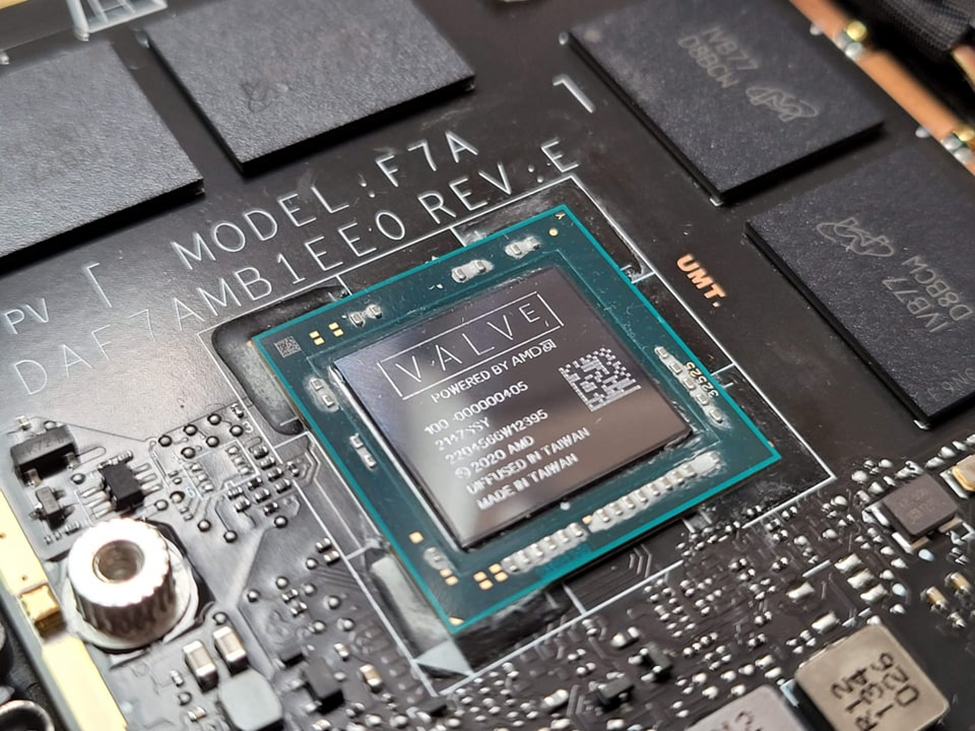AMD’s Steam Deck APU 0405m, introduced in February 2022, features a Zen CPU and RDNA 2 GPU with four symmetrical clusters, each containing 512 floating-point processors. Running at 1.6GHz, it prioritizes low power over high clock speed for handheld use. The RDNA-style cache and architectural advantages contribute to improved latency and impressive gaming performance. On November 16, 2023, new models with 512GB and 1TB storage, OLED display, Wi-Fi 6E, Bluetooth 5.3, and enhanced cooling replaced the previous LCD variant. The upgraded APU, named Sephiroth, reflects AMD’s commitment to innovation and gaming performance.

What do we think? AMD’s gaming APU has proven to be the most popular chip for handheld gaming machines, with over six design wins. Although the Steam Deck has proven to be very popular, it remains to be seen if it and the Chinese copies of it will enjoy similar success.
AMD introduced the Steam Deck Van Gogh APU 0405m in February 2022, with a Zen CPU and RDNA 2 GPU, and some dark silicon for Magic Leap—an economy-of-scale move on AMD’s part.
There are four symmetrical clusters within the GPU, which used the architectural RDNA 2 layout of two compute units per cluster that AMD refers to as (workgroup) WGPn. Each WGP has two groups of 32 ALUs, giving the entire chip 512 32-bit floating-point processors (8×32×2).
The GPU ran up to 1.6GHz—a lower than normal clock speed for RDNA 2. As a handheld device, case temperature was important, so the chip emphasized low power over absolute performance, operating at a lower frequency compared to high-end AIBs like the RX 6900 XT.
The GPU 0405 also used an RDNA-style cache with 16KB first-level vector and scalar caches, backup by a 128KB L1. The RDNA’s architectural benefits offered improved vector memory access latency compared to AMD’s previous architecture, the Vega Graphics Core Next (GCN) GPU. Although the scalar cache access latency was similar, RDNA’s 128KB L1 provided an advantage, contributing to Van Gogh’s impressive performance, even with a slightly lower clock rate.
DRAM latency in a unified memory architecture (UMA) will always be a challenge, but RDNA 2’s memory latency usually outperforms GCN-based architectures. However, the custom 0405 GPU demonstrated noteworthy bandwidth improvements. It realized more than 70GB/s, surpassing AMD’s Renoir’s iGPU and highlighting Van Gogh’s emphasis on gaming performance.
Integrated GPUs with UMA suffer bandwidth limitations due to prioritizing CPU access to the memory. Unlike CPUs relying on cache, GPUs require substantial and sustained memory bandwidth, especially with larger data models.
On November 16, 2023, two new APUs were introduced with internal storage options of 512GB and 1TB designed to drive an OLED screen. These models serve as replacements for the earlier LCD variant. The original units with 64GB and 512GB have been discontinued, while the 256GB LCD version now serves as the new baseline model. Upgrades in the new Steam Deck encompass a larger 7.4 inches (19cm) OLED display with a 90Hz refresh rate, support for Wi-Fi 6E and Bluetooth 5.3, a battery boasting an estimated 25% increase in capacity, and enhanced cooling mechanisms. Notably, the OLED deck incorporates a revamped APU known as Sephiroth, produced using a 6nm processor and inspired by the character from Final Fantasy VII.
For a remarkable in-depth tour of the elements in the AMD APU, look at this video.